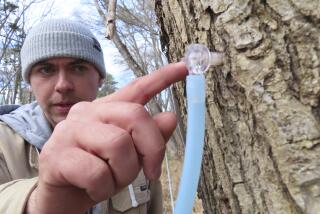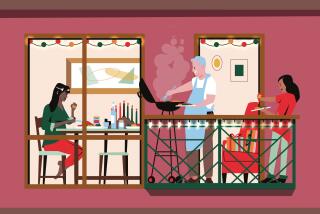Jammin’ : A Preserving Tradition
- Share via
Edon Waycott comes to the Santa Monica Growers Market dressed in gym shorts and T-shirt, running shoes and baseball cap. She’s ready for work.
It’s a good thing. Before the morning is over, she’s walked the entire market two or three times, shouldering through the throngs, asking farmers questions and looking for fruit.
“What have you got for me today?” she asks one, who has beautiful peaches stacked in pyramids on the table in front of him.
“Well, I’ve got these, they’re $2 a pound,” he says.
“Haven’t you got anything else?” she asks.
“I’ve got some in the back,” he says, “but they’re not too pretty.”
At this, Waycott brightens. “That will be fine.”
“They’re not as nice as these,” the farmer says, “So I’ll give them to you for $14 a flat.”
Waycott pays and says she’ll be back later to pick them up. She’s got more shopping to do, but at least now she knows one item for this week’s inventory. Within a couple of days, those peaches will be selling for $6 a half-pint, converted into jam.
In addition to making preserves under the Edon’s Spoonable Preserves label (sold only at La Brea Bakery and at La Paneterie in the Brentwood Country Market), Waycott is the author of the recently published “Preserving the Taste” (Hearst Books: 1993, $15).
“I’ve made something out of indigenous fruits or vegetables all my adult life,” says Waycott, who grew up in New Jersey but maintained close ties to the family farm in North Carolina, where her grandmother was an old-fashioned, preserve-packing farm wife.
“I guess that kind of stuck to me by osmosis,” she says. “All the women in my family are wonderful cooks. Wherever I’ve lived--Washington, Kansas City, summers on Cape Cod--all of those regions have very specific indigenous produce, and I couldn’t let the summer go by without savoring some and putting some away for winter.
“Obviously, putting things up, canning, making jam and jelly . . . they don’t have the necessity overtones they used to. My grandmother had to put up green beans because otherwise she wouldn’t have them all winter. Now we do it as a treat and as a little taste reminder of what was growing before. And, more importantly, with jams and jellies, you’re certain you can make a better product than what is out there. That has been my prime reason.”
As she stalks the market, it is evident Waycott is a canny shopper--but not in the traditional sense. Passing one display of plums so beautiful they look like art objects, she shakes her head. “I may come back for one or two for lunch, but I would never put them into jam. For jam, you want to take home the ugly ducking. You’re going to cut it up. It’s not going to be in a wonderful display. You’re going to desecrate it. Have some mercy.”
Waycott went pro as a “jammer” after working with Campanile’s Mark Peel and Nancy Silverton on an as-yet unpublished cookbook. She managed their La Brea Bakery for a year and, surrounded by mountains of bread, started bringing in her homemade jams and jellies. Most were made from fruits grown around her Pacific Palisades home.
“Nancy was very enthusiastic and asked what I would think about making the jam for the cafe,” she says. “Naively, I said sure, not knowing that it would be 30 quarts a week I would end up having to crank out. It really evolved into a business, but it stayed a cottage industry. I really keep the lid on it. I personally make every batch.”
More to Read
Eat your way across L.A.
Get our weekly Tasting Notes newsletter for reviews, news and more.
You may occasionally receive promotional content from the Los Angeles Times.











